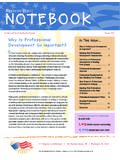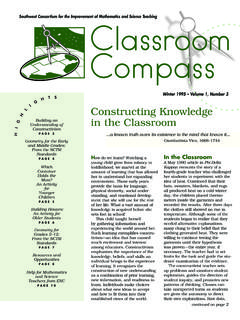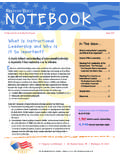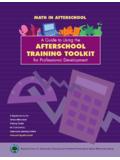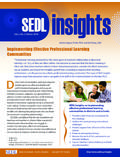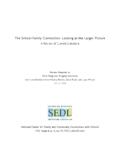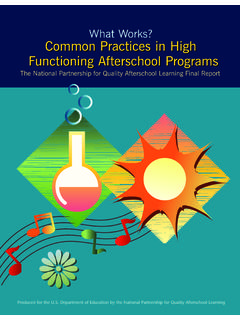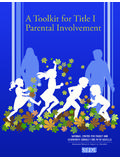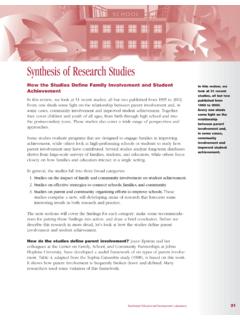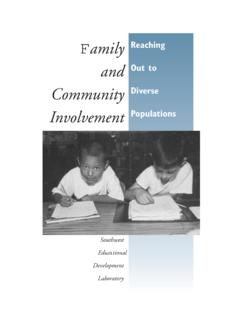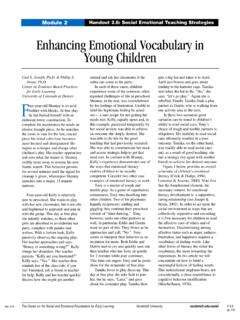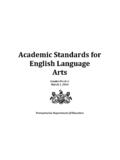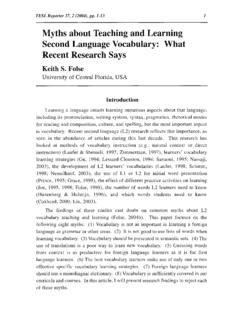Transcription of Energy All Around Us: Light, Heat, and Sound - AIR | SEDL
1 Grade 1 Energy All Around Us: light , heat , and SoundAcknowledgmentsThe MOSAIC Program was made possible through a grant from the Sid W. Richardson Foundation of Fort Worth, Texas. Since 1947, the Foundation has generously supported education, healthcare, human services, and culture in : An Integrated Approach to Mathematics, Science, Technology, and Language represents a significant revision and update of Integrating Mathematics, Science, and Language: An Instructional Program (Paso Partners), produced in 1993 by Betty J. Mace-Matluck and Norma G. Hernandez, and developed by a partnership of three public schools, an institution of higher education, and SEDL 2012 SEDLAll rights reserved. Educators and nonprofit organizations are welcome to use excerpts from this publication and distribute copies at no cost to recipients.
2 Such users should credit SEDL as publisher and respect the copyrights of designated illustrators, designers, and contributors. For additional uses of this publication, including reproduction or utilization in any form or by any means, electronic or mechanical ( , photocopying, recording, or by any information storage and retrieval system), please request permission in writing from SEDL at 4700 Mueller Blvd., Austin, TX 78723 or by fill-ing out and submitting a SEDL Copyright Request Permission form at on the SEDL Mueller , TX 2012 by SEDL mosaic Grade 1iiiGrade 1mosaicContentsIntroduction ..1 Language Objectives for English Learners ..2 The 5E Lesson Cycle ..3 Background Knowledge ..6 Lesson Overview ..7 Big Ideas ..7 Concepts ..7 Language Support for English Learners ..8 Lesson Procedures.
3 9 Engage ..9 Sound ..9 light ..10 heat ..11 Explore ..13 General Instructions for Explore Centers ..13 light Center: Shadow Squares ..13 heat Center: Plastic Cup Thermometer ..14 Sound Center: Tissue Box Guitar ..14 Explain ..16 General Instructions ..16 light Center: Shadow Squares ..16 heat Center: Plastic Cup Thermometer ..17 Sound Center: Tissue Box Guitar ..18 Sound and Measurement ..18 Elaborate ..20 Uses of Energy ..20ivmosaic Grade 1 Copyright 2012 by SEDL Evaluate ..21 Group Project ..21 Individual Assessment ..22 Assessment Support for English Learners ..23 Resources ..24 Materials List and Details ..24 Frequent English/Spanish Vocabulary Words ..28 Handouts ..40 Explore Resources light Center Instructions.
4 40 light Center Data Sheet ..41 heat Center Instructions ..42 heat Center Data Sheet ..43 Sound Center Instructions and Data Sheet ..48 Evaluate Resources Group Project Rubric ..49 Energy Assessment Teacher Instructions ..50 Energy Assessment ..51 Reading Connections ..53 Texas Essential Knowledge and Skills (TEKS) Focus ..54 References ..58 Copyright 2012 by SEDL mosaic Grade 11 Grade 1mosaicIntroductionThis lesson on Energy is one part of a K 5 instructional cross-curriculum program that integrates science, mathematics, and technology applications. The concepts in the lesson support the imple-mentation of the 2010 2011 Texas Essential Knowledge and Skills (TEKS) as well as the Texas Eng-lish Language Proficiency Standards (ELPS). The ELPS provide guidance for teachers working with English learners in the core content cross-curricular integration in this lesson includes inquiry-based activities to engage students with content while teaching higher-order thinking skills and facilitating understanding of the con-nections among math, science, and technology.
5 The National Science Education Standards (National Research Council, 1996) describes inquiry-based instruction as the activities of students in which they develop knowledge and understanding of scientific ideas, as well as an understanding of how scientists study the natural world (p. 23). Inquiry-based instruction must be carefully structured to ensure that students engage in investigations that deepen and expand their scientific knowledge as well as develop their scientific habits of mind. In A Framework for K 12 Science Education (2012), the National Research Council has redefined inquiry as scientific and engineering practices. To promote such practices, teachers should provide learning experiences that engage students with fundamental questions and guide them in how to find the addition to the integration of math, science, and technology, this module provides a list of related reading resources that may be used during reading or storytelling time.
6 The books could also be used as an additional resource during the investigations and group activities. You may want to consult with the school librarian or a local community library to reserve as many of these books as possible for use during this All Around Us: light , heat , and Sound2mosaic Grade 1 Copyright 2012 by SEDLL anguage Objectives for English Learners Effective instruction in second language acquisition involves giving ELs opportunities to listen, speak, read, and write at their current levels of English development while gradually increasing the linguistic complexity of the English they read and hear and are expected to speak and write. The ELPS and Texas English Language Proficiency Assessment System (TELPAS) define four English language proficiency levels: beginning, intermediate, advanced, and advanced high.
7 These levels are not grade-specific, although there is a grade band for grades K 1 and a second for grades 2 12. ELs also may exhibit different proficiency levels within the language domains of listening, speaking, reading, and writing. The proficiency level descriptors outlined in the chart below show the pro-gression of second language acquisition from one proficiency level to the next for each language domain. These descriptors serve as a road map to help content-area teachers instruct ELs in ways that are commensurate with students linguistic HighListeningBeginning English learners (ELs) have little or no ability to under-stand spoken English used in academic and social settings. Intermediate ELs have the ability to understand simple, high-frequency spoken English used in routine academic and social settings.
8 Advanced ELs have the ability to understand, with second language acquisition support, grade-appropriate spoken English used in academic and social high ELs have the ability to understand, with mini-mal second language acquisition support, grade-appropriate spoken English used in academic and social English learners (ELs) have little or no ability to speak English in academic and social settings. Intermediate ELs have the ability to speak in a simple manner using English com-monly heard in routine academic and social ELs have the ability to speak using grade-appropriate English, with second language acquisition support, in academic and social settings. Advanced high ELs have the ability to speak using grade-appropriate English, with minimal second language acquisition support, in academic and social English learners (ELs) have little or no ability to use the English language to build foundational reading skills.
9 Intermediate ELs have a limited ability to use the English language to build foundational reading ELs have the ability to use the English language, with second language acquisition support, to build foundational reading high ELs have the ability to use the English language, with minimal second language acquisition support, to build foun-dational reading skills. WritingBeginning English learners (ELs) have little or no ability to use the English language to build foundational writing ELs have a limited ability to use the English language to build foundational writing ELs have the ability to use the English language, with second language acquisition support, to build foundational writing high ELs have the ability to use the English language, with minimal second language acquisition support, to build foun-dational writing Proficiency DescriptorsFrom: Educator Guide to TELPAS: Grades K 12 (pp.)
10 15, 22, 30, 40, 78, 84) by Texas Education Agency (TEA), Student Assessment Division, 2011, Austin, TX: TEA. Copyright 2011 by TEA. Available from Adapted by SEDL with 2012 by SEDL mosaic Grade 13 The 5E Lesson CycleThe 5E lesson cycle provides a structure for implementing learning activities that elicit and build on students existing knowledge to expand and deepen their understanding of that knowledge. Each of the 5Es describes a phase of learning: Engage, Explore, Explain, Elaborate, and Evaluate. The lesson cycle should be implemented in its entirety, and educators should avoid pulling selected activities and using them in a piecemeal fashion. The 5Es are designed to introduce and develop deeper conceptual understanding in a carefully constructed sequence. The ELPS are embedded into the 5E lesson cycle to provide strategies and techniques for teachers to use as they shelter science and mathematics content and academic English.
